Overview:
When used properly, mulches and composts can improve soils and provide many beneficial effects to plant health and vigor. Undesirable nuisance fungi, however, may also occur when different types of mulches or composts are used under certain conditions. Some of the more common examples of these nuisance fungi include the shotgun or artillery fungus (Sphaerobolus), slime molds (Physarum), stink horns (Mutinus), bird’s nest fungi (Crucibularium), toadstool mushrooms, and several plant pathogens. Although these nuisance fungi are mostly natural decomposers of organic matter and most of them are harmless, this blog discusses how the various nuisance fungi sometimes associated with mulches and composts can be controlled or minimized.
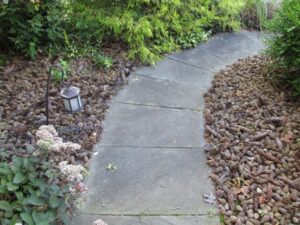
Organic landscape mulches & composts under certain conditions can promote nuisance fungi. (Photo Credit: Steven K. Rettke, Rutgers Coop. Ext.)
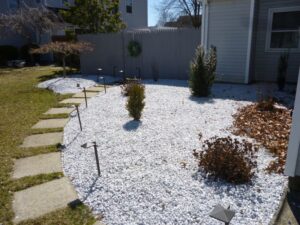
Although stone mulch will certainly eliminate any growth of nuisance fungi, it does not benefit plant health. (Photo Credit: Steven K. Rettke, Rutgers Coop. Ext.)
Some Common Nuisance Fungi:
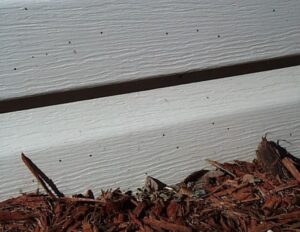
Artillery Fungus shoot dark colored spores that create tar-like spots on house siding. (Photo Credit: Steven K. Rettke, Rutgers Coop. Ext.)
The artillery fungus (Sphaerobolus) found in mulched areas has probably caused the most concern to landscapers and potentially pose some economic concern to their clients. This fungus produces fruiting structures that resemble tiny cream or orange-brown cups that hold a spore mass resembling a tiny black egg (0.1 inch in diameter). When enough water accumulates, the spores are shot high into the air up to several yards. The dark colored spores resemble small tar spots and will stick to house siding, downspouts, cars, leaf surfaces, and any nearby structure. The artillery fungus is strongly phototrophic & will shoot their spores toward light sources or white colored surfaces. The spores have extreme adhesive qualities & are difficult to remove, even with high pressure sprayers.

Close-up of the Artillery Fungus on house siding. This fungus will often shoot their spores toward white surfaces. (Photo Credit: Steven K. Rettke, Rutgers Coop. Ext.)
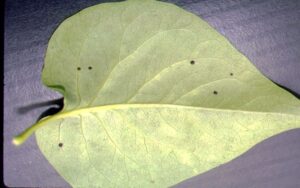
No, the dark spots stuck to the leaf underside are not scales, but are Artillery Fungus spores. (Photo Credit: Steven K. Rettke, Rutgers Coop. Ext.)
The slime molds (Physarum) in fact, are not a fungus, but are soil-dwelling amoeba. They are a single-celled organism that contain multiple nuclei when they clump together to form a single mass. They can potentially move several feet per day over mulched landscape beds. Slime molds can also climb vertically up plants. Slime molds have numerous colored species, but the “dog vomit” species has a white color & is commonly observed in our area. Although this amoeba is harmless to plants & animals, to some sensitive individuals, the “blob” can humorously cause ‘psychological trauma,’ because of its’ ability to move.
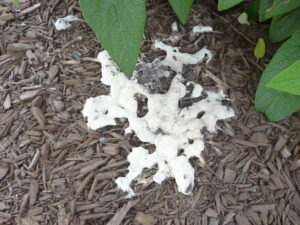
Slime Mold amoeba can clump together when looking for food . (Photo Credit: Steven K. Rettke, Rutgers Coop. Ext.)
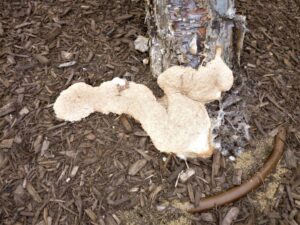
The Slime Mold has fully clumped together to form a single cell with multiple nuclei. (Photo Credit: Steven K. Rettke, Rutgers Coop. Ext.)
Stinkhorn fungi grow on organic, decomposing hardwood mulch. The common stinkhorn (Phallus impudicus) is often found in coniferous forests & has a strong, objectionable odor. The dog stinkhorn (Muinus caninus) is commonly found growing within landscape mulch and is smaller & less odorous. The numerous species all have a slimy, gelatinous body surface that emerge during rainy periods, but will shrink & dry out on their own in a few days after the weather dries. They often will be seen growing together in large clusters. Despite the odor & sometimes distinctive coloration, these fungi are not considered toxic to plants or poisonous to people.
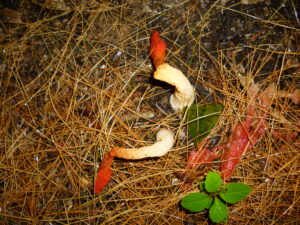
The Dog Stinkhorn Fungus has a slimy, gelatinous body surface. It shamelessly displays an obvious phallic appearance. (Photo Credit: Steven K. Rettke, Rutgers Coop. Ext.)
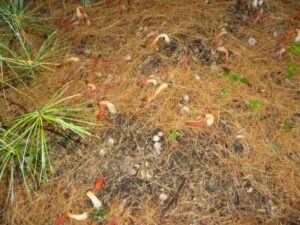
The Stinkhorn Fungus will often be found growing together in large clusters. ((Photo Credit: Steven K. Rettke, Rutgers Coop. Ext.)
The bird’s nest fungi (Crucibularium) are commonly encountered nuisance fungi found in landscape mulch. Their fruiting bodies resemble tiny egg-filled birds’ nests (0.25-0.5 inches in diameter). They are much larger than the artillery fungus structures but are often found together feeding on decomposing organic matter such as wood chips or bark mulch. The nests are “splash cups” & when raindrops strike at the right angle, then the fruiting bodies or “eggs” are expelled from the nest for distances of 2-3 feet. The fruiting bodies are gregarious & will be found clumped together in groups, but not joined together.
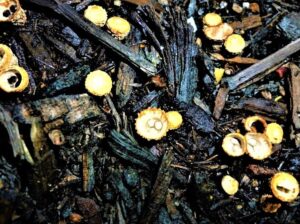
The Bird’s Nest Fungus have fruiting bodies that resemble tiny egg-filled birds’ nests. (Photo Credit: Steven K. Rettke, Rutgers Coop. Ext.)
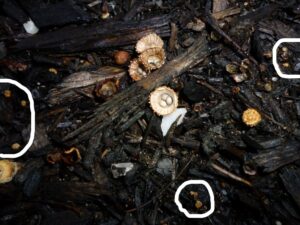
Artillery Fungus growing along-side Bird’s Nest Fungus. White circled areas contain apparent Artillery Fungus structures. (Photo Credit: Steven K. Rettke, Rutgers Coop. Ext.)
Toadstool mushrooms are collectively a grouping of mushroom species that are poisonous & potentially deadly if consumed. Like all the mulch nuisance fungi discussed in this blog, these mushrooms are primarily hardwood mulch decomposers. The danger associated with the toadstool mushrooms are, of course, their toxic poisons if unknowingly consumed. A deadly poisonous toadstool mushroom species when consumed is known as the death cap (Amanita phalloides). Although more commonly found in Europe, it can sometimes be observed in our area. It takes knowledge & experience to identify the key botanical mushroom features that determines if a species is edible or poisonous.
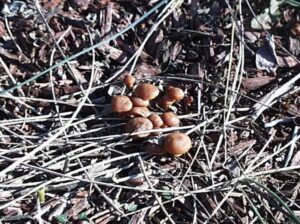
Are these potential Toadstool Mushrooms? Unknown. Would need to examine closely to identify species. (Photo Credit: Steven K. Rettke, Rutgers Coop. Ext.)
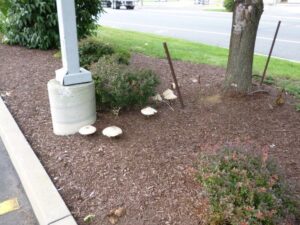
Are these potentially Toadstool Mushrooms? Unknown. Would need to examine closely to identify species. (Photo Credit: Steven K. Rettke, Rutgers Coop. Ext.)
Why Nuisance Fungi Occur in Mulch:
Most of the nuisance fungi problems in the landscape increase when mulch is created from both fresh hardwood bark (usually oak and maple) and fresh ground wood originating from almost all tree species. Such wood products decompose readily because they contain large concentrations of cellulose. The finer the wood products are ground, the more troublesome the problem will be. This will particularly be true if the particle size drops below 3/8th of an inch in diameter. Alternatively, the bark chips (nuggets) from mature softwood trees (such as pine or cypress) contain mostly lignin, wax, and protected cellulose that are more resistant to decay. Consequently, they will usually produce fewer problems. However, fresh mulch from young softwood trees do not contain bark cellulose with protective lignin waxes or tannins. These rot resistant materials do not form within softwood trees until they have matured. Therefore, mulch from young trees is more vulnerable to rapid decomposition and colonization by nuisance fungi.
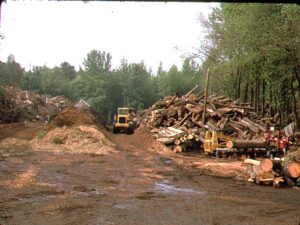
Nuisance fungi can be more problematic in mulch made from fresh hardwood bark. (Photo Credit: Steven K. Rettke, Rutgers Coop. Ext.)
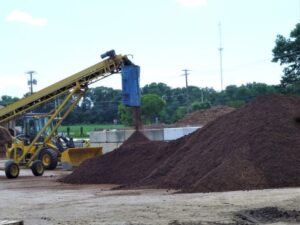
The finer the wood mulch is grounded, the more troublesome nuisance fungi can become. (Photo Credit: Steven K. Rettke, Rutgers Coop. Ext.)
Composted Mulch:
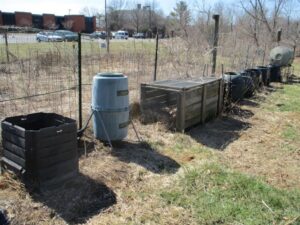
A variety of composting methods on display by the Monmouth County Master Gardeners. (Photo Credit: Steven K. Rettke, Rutgers Coop. Ext.)
A recommended way to avoid the problem of nuisance fungi and to maximize the benefits of mulching is to add nitrogen and then compost the mix for a minimum of 6 weeks. The nitrogen source can include grass clippings, poultry manure and urea (applied at a rate of 1# of available nitrogen per cubic yard of mulch material). An alternative is the addition of 10-15% by volume of composted sewage sludge to the hardwood bark or wood mulch.
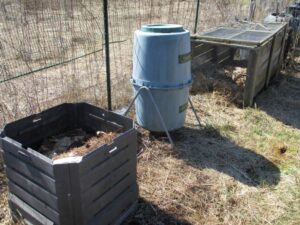
Nuisance fungi can still potentially inhabit composted mulch when it cools after being applied in the landscape. (Photo Credit: Steven K. Rettke, Rutgers Coop. Ext.)
How Temperature, Moisture & pH Influence Nuisance Fungi:
Sometimes high quality, composted mulch products are applied around the landscape and yet problems with colonization by undesirable fungi still occur. This scenario can happen when thermophiles (i.e., microorganisms requiring high temperatures to survive) that thrive during the composting process begin to die when temperatures cool to the 50-80℉ range after application. This “biological vacuum” within the fresh compost is rapidly colonized by mesophiles (low temperature microorganisms). If the composted mulch is dry (i.e., moisture content is below 35%) when it is applied, some of the nuisance fungi can become the primary colonizers. The chances for potential problems occurring in the future are then more likely to happen, especially if the mulch is applied too deeply (4 inches or more).
The pH levels can also predetermine the likelihood of nuisance fungi colonizing the mulch. When pH drops below 5.2, then beneficial bacteria/fungi that inhibit nuisance fungal growth cannot colonize and compete successfully. Sour mulches can have a pH range as low as 2.5 to 4.8 and will not only promote the growth of fungi but are toxic to most plants.
Reducing Problems Before They Start:
Applying water to dry mulch or compost materials as they are placed in the landscape can prevent many of the fungal nuisance problems. It is important to soak all mulches immediately after they have been applied. Once the water content of mulch exceeds 40% (50% is even better) by total weight, the high-moisture organic matter is rapidly colonized by beneficial bacteria & fungi within the first few days enabling them to compete with the nuisance fungi.
Sour mulches with pH levels below 5.2 should not be applied within the landscape. The low pH and resulting fungal problems are usually prevented if the wood and bark products are nitrified (i.e., addition of 1 lb. of an accessible N source per cubic yard of mulch) and composted.
Generally, a good game plan to follow when using mulch in the landscape is to purchase composted products that have a low % of woody material. Remember, softwood bark is rot resistant and does not promote the growth of nuisance fungi. Fresh woody products (i.e., grounded wood pallets), having particle sizes less than 3/8 inches in diameter should especially be avoided unless they are composted first. If composting fresh woody products is not feasible, then coarse particles greater than ¾ inches should be applied. The larger diameter mulches will less likely create problems if they are not applied to a depth greater than two inches. Finally, fluffing the mulch up at least twice a year may help by disrupting the formation of spores.
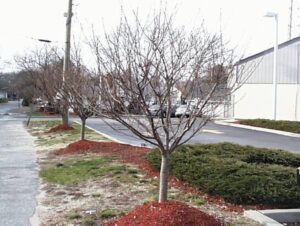
Mulch volcanoes create multiple problems for plants & nuisance fungi can be added to the list. (Photo Credit: Steven K. Rettke, Rutgers Coop. Ext.)
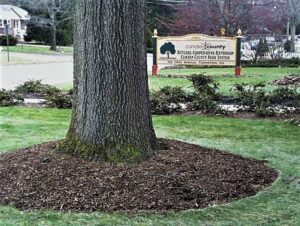
Properly applied mulch apron around this large red oak. Former grounds of the Camden County cooperative extension office. (Photo Credit: Steven K. Rettke, Rutgers Coop. Ext.)
Solutions After Mulch Problems Occur:
Once nuisance fungi have colonized and become a problem within mulched areas, control options are often limited. Probably the most attempted solution is the application of fresh dry mulch on top of the existing mulch colonized by nuisance fungi. Such an approach rarely solves anything, since the problem will occur again the following year, if not sooner, and likely become worse. A more effective control is to simply spade the infected mulch into the soil layer and then thoroughly soak with water. The best control option is to remove the mulch and place it in a heap after completely wetting it. This will promote self-heating and once temperatures reach a range between 110-140℉, the nuisance fungi will be destroyed.

Often times raking is the simplest & relatively effective method to deal with nuisance fungi. (Photo Credit: Steven K. Rettke, Rutgers Coop. Ext.)
(Reference: OSU Extension Fact Sheet, “Control of Nuisance & Detrimental Molds in Mulches & Composts.”)

